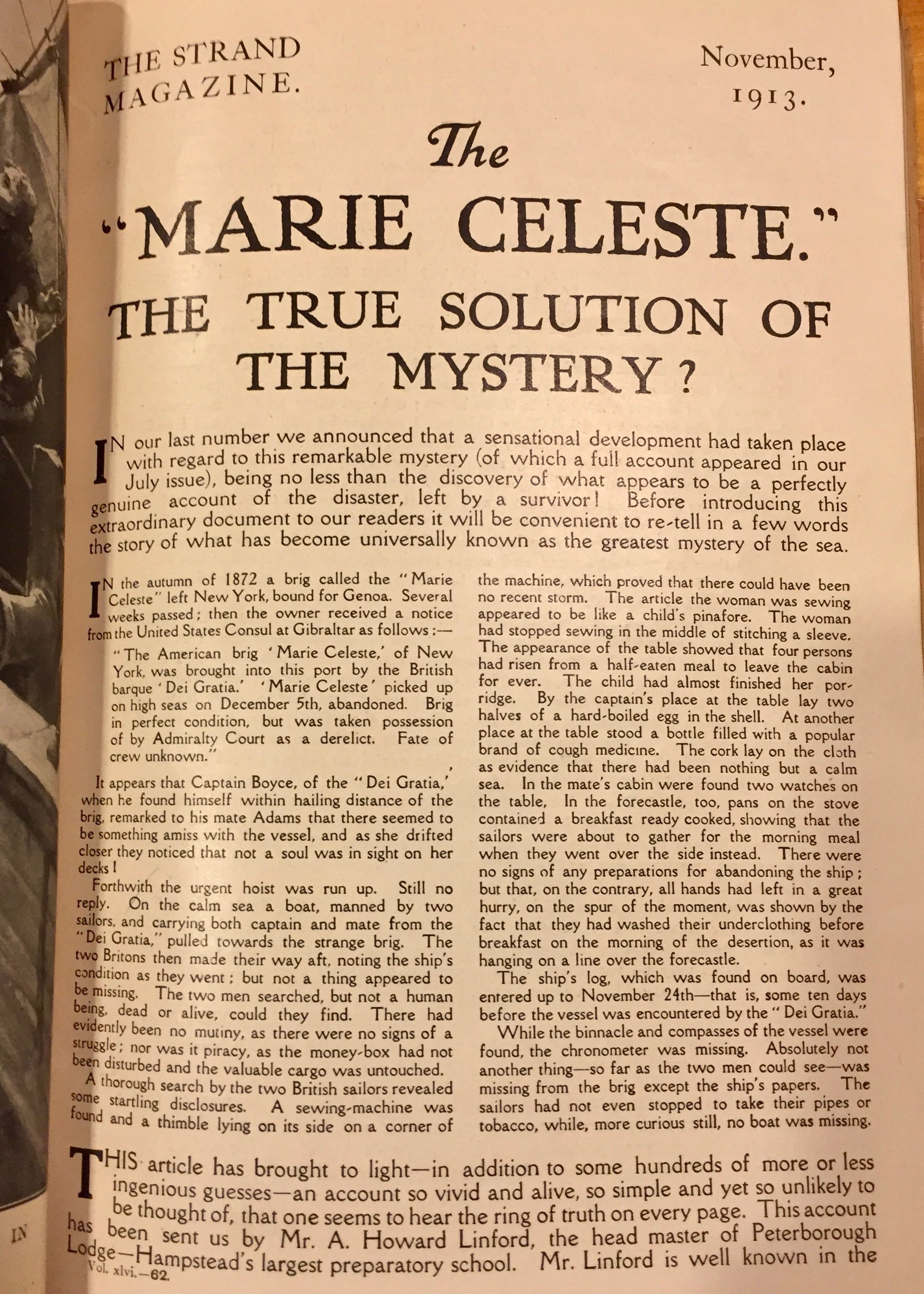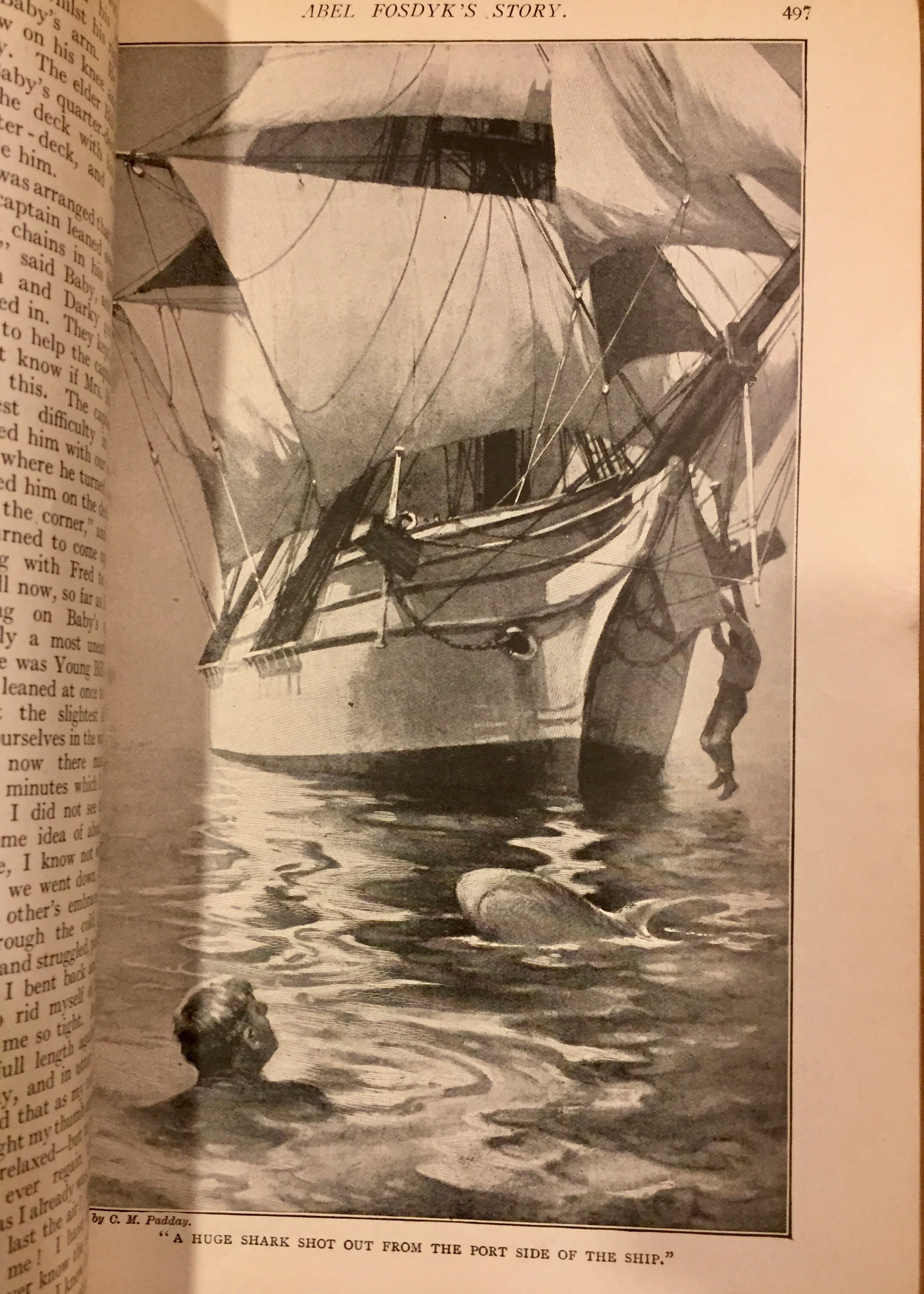A Unique Book
Starrett, a mystery at sea, and a fragile little volume
Where to begin?
Peking in 1936?
Maybe The Strand Magazine in 1913?
Perhaps we should go back to the Cornhill section of London circa 1884?
No, it’s best if we start (as the organizational expert Maria von Trapp advised) at the very beginning: December 5, 1872, about 400 miles east of the Azores.
A later reprint of Conan Doyle's fictionalized account of the Mary Celeste mystery.
The crew of the Die Gratia, a British ship, has caught sight of a brigantine named the Mary Celeste, floating aimlessly in the North Atlantic. When the crew boards the Mary Celeste, they find the ship largely intact, with some water in the hold and one of its lifeboats missing.
Also missing is the crew including the captain and his family. None were ever seen alive again.
The story of the Mary Celeste became a maritime mystery that piqued the interest of a young doctor who was hoping to start a successful writing career. Arthur Conan Doyle let his imagination roam, and he came up with an explanation for most of the known facts about the ghost ship for a short story he called “J. Habakuk Jephson’s Statement.”
Cornhill magazine published his effort without a byline in January 1884.
“I had a reverence for this splendid magazine with its traditions from Thackeray to Stevenson and the thought that I had won my way into it pleased me even more than the cheque for £30, which came duly to hand,” writes Conan Doyle in his autobiography, Memories and Adventures.
The story was a hit, and the public soon blended Conan Doyle’s fictional story about the Marie Celeste with the historical facts about the Mary Celeste.


Over the decades, there would be numerous theories about what happened to the captain, his family and crew. Everything from sea monsters to pirates to mutiny was proposed, some only tongue-in-cheek.
What was certain was that the mystery meant good business.
Which is why it is no surprise that our old friend, The Strand Magazine, joined in the discussion over the course of several issues in 1913.
In the number for July 1913, the magazine offered a splashy headline that ran over two pages. It then reviewed the facts of the matter, after a fashion.
The Strand called the ship by Conan Doyle’s name—Marie Celeste—rather than its true name—Mary Celeste. The article then recounted Conan Doyle’s explanation, along with four additional theories. Few of the theorists had sea-faring experience (unlike Conan Doyle, who had served aboard whaling ships), and they soon broke down under scrutiny.
A preface to the July article invited the public to share its own theories with the magazine.
An advertising page from Starrett's little booklet of Strand pages.
The Strand kept up interest in the story for months. A small note in the September issue promised “a most unexpected development” on the case next month. (That note is reproduced at the top of this article.)
And the October issue of The Strand had an extended advertisement promising word of “A Sensational Development.” The advertisement goes on to breathlessly say:
“This is no less that the discovery of what appears to be a perfectly genuine account of the disaster, left by a survivor! The explanation is complete in every detail, and yet so out-of-the-way that the most ingenious writer would have been to the last degree unlikely to hit upon it. This extraordinary document will appear in our November issue.”
It is nice to note that the same advertisement promotes a new story by Conan Doyle “The Horror of the Heights.” If you've read it (and you should—it's ACD's story telling at his best), you know it features terror in the skies, not the seas. It, too, would appear in the November 1913 issue.


The November number of The Strand starts a two-page history of the mystery, and then offers the allegedly true testimony of one Abel Fosdyk (a Monty Python name if there ever was one), a “survivor” of the Mary/Marie Celeste.
This heavilly illustrated account created a sensation, with news reports being generated by other media about a solution to the long-stading sea mystery.
Sadly, Abel Fosdyk and his account were both manufactured.
Abel Fosdyk’s account today would now be regarded as, well, fake news.
Still, it's likely The Strand saw its circulation sky rocket because of the "true account" that's what kept the mystery alive.
So much for 1913.
(By the way, this is as good a place as any to mention that the quality of the illustrations that accompany this article aren't up to my usual standard. The fragile nature of the booklet prevents me from scanning anything except for the cover, and I shot the rest of the images with a cell phone camera. Still, I think you get the idea.)
The fragile 1936 booklet created by Starrtt while living in Peking.
What brings us here today is this little booklet, created 23 years later, in 1936.
The booklet is roughly 9.25 X 6.5 inches.
The paper used for the covers has browned considerably and is growing stiff and fragile. Even as I handle it now, tiny flecks of paper drop onto the desk. The glue that once held it together has also started to separate.
This is a fragile booklet, although the interior pages from The Strand remain bright, supple and clean.
If the booklet binding is fragile, it is also I believe, unique. In all my years of collecting Vincent Starrett items, I’ve not seen another booklet like it.
Let’s look at the cover.
The Mystery of the
”Marie Celeste”
(line)
[Excerpts from the
Strand Magazines]
1913
Vincent Starrett
Peking, 1936
Ray and Vincent Starrett in Peking. From The Last Bookman by Peter Ruber.
A little history: In 1936, Starrett was enjoying (however briefly) the life of a rich writer. He had sold several of his book plots to Hollywood to use as the basis for films. He then packed up Ray and headed out of Chicago and around they world. They landed in the expatriate colony in Peking (now Beijing) in the years before the first Chinese civil war made itself felt in that city. Starrett and Ray loved it here and the colony would be the basis for one of his last mystery novels, Murder in Peking.
It is also in Peking that Starrett likely found back copies of The Strand Magazine. That would not have been unusual, since there had been a thriving British and American group in Peking for years. Starrett also writes in his memoirs of adventuring through Chinese bookshops, which is where he first learned of Chinese detective stories, a subject he helped to popularize when he returned to the States after war made Peking too hot.
The hand written title page.
I can see him going through The Strands and finding these articles about the Mary/Marie Celeste. His knowledge of Conan Doyle’s version of events would no doubt have intrigued him and prompted him to have the pages cut out and bound together with the cover and title page done over in his own hand.
Let’s turn back to the booklet.
The title page contains much the same information as the cover.
The ‘Marie Celeste’
(lines)
Excerpts from the Strand
Magazines — 1913 —
Vincent Starrett
1936




What follows are roughly 22 pages that have been sliced out of copies of The Strand. The first page of each article has a notation on the date by Starrett.
The first, headlined “The Greatest Mystery of the Sea: Can You Solve It?” is the piece from July 1913. It’s a six-page article, and Starrett has included the little teaser from the September issue, plus a larger advertisement from the October issue promising “a perfectly genuine account of the disaster, left by a survivor!”
The November article is the longest, clocking in at 17 pages, with the full Fosdyk account accompanied by multiple imaginative illustrations. While the Fosdyk piece has been discounted as fiction, The Strand put all its considerable weight behind the piece, with full-page illustrations that show all the drama of the account.
I've included several pages here so you can get a sense of how it was presented.
Altogether, it’s a remarkable find and I’m thrilled to add it to the shelves.
Roy Pilot and myself at the Baker Street Irregulars dinner in January 2017.
My acquisition of the booklet would not have been possible without the thoughtfulness of an old friend, Roy Pilot, BSI, of Michigan. Roy has an extensive Arthur Conan Doyle collection, including a large collection related to the Mary/Marie Celeste.
I was able to acquire this item from Roy during the recent BSI Birthday Weekend.
Although I tease him unmercifully (which he returns in kind), I am quite serious when I say that Roy is true Arthur Conan Doyle scholar of the highest level. He is very careful and detailed in his work, taking pains to not only read what Conan Doyle wrote, but to read the same sources Conan Doyle used in creating his stories. Just tracking those books down is a feat. It takes years of dedication and that's what Roy has devoted to his Conan Doyle work.
One of the favorite books in my collection is The Annotated Lost World by Roy and the late Al Rodin. If you don’t own this book, make it a point to hunt down a copy. The book was beautifully produced by Wessex Press, and it a true pleasure to read.
BTW, Roy has another book in the offing involving one of Arthur Conan Doyle’s other non-Sherlockian works. More on that when the time is right.
Stay tuned.
The dust jacket to The Annotated Lost World, published in 1996 by Wessex Press and annotated by Roy Pilot and the late Al Rodin. If you don't have it, get it.
